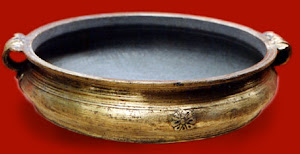Kerala's cuisine is traditional and is quite different from the food in the north. Since the general food in Kerala is similar to the other south Indian states, I researched on what is called Onam Sadhya (unique about Kerala).
About Onam:
Onam is the biggest festival in the Indian state of Kerala. Onam Festival falls during the Malayali month of Chingam (Aug - Sep) and marks the homecoming of legendary King Mahabali. Carnival of Onam lasts for ten days and brings out the best of Kerala culture and tradition. Intricately decorated Pookalam, ambrosial Onasadya (Onam Sadhya), breathtaking Snake Boat Race and exotic Kaikottikali dance are some of the most remarkable features of Onam.
About Onam Sadhya:
Sadhya means "big feast" in Malayalam. A Sadhya is a big feast associated with a special occasion, such as a marriage, birthday, childbirth, or death ceremony. A Sadhya is traditionally a vegetarian meal served on a banana leaf; people eat sitting cross-legged on the floor. The idea of making many dishes in the Sadhya is that there will be at least two or three dishes liked by everybody.

How is it Served:
There is a distinct order of serving the the grand feast of Onam.
- Pappad or Pappadum is to be served on the extreme left. On top of the big pappadum banana is served. The banana can be 'Rasakadali', 'Poovan', 'Palayankodan'.
- From the right pappad - salt, banana wafers, sarkarapuratti fries are served. After this, ginger lime and mango pickles are served. Next comes 'vellarika', 'pavakka', beetroot and 'ullikitchadi'. 'Kitchadi' made of pineapple and banana splits or of grapes and apple is served along with this.
- On the right, 'cabbage thoran' is served. Then comes a thoran made of beans and avil followed by bread and green peas mix 'thoran'. The meal will be complete with the 'avial' and 'kootu curry'.
- Rice is served when the guests seat themselves and just two big spoons is considered enough. After this 'parippu' and ghee is poured. Then comes Sambhar. Desserts are to begin with adaprathaman followed by 'Kadala Payasam'.
- This colourful arrangement on the lush green banana leaf makes the food look even more tempting and irresistible .
- First full course meal is served for Lord Ganapathi in front of a lighted oil lamp (Nila Vilakku). This is in accordance with the Malayalese trend of starting everything in the name and presence of God.
The bananas form an integral wing of the cuisine of Kochi. The main reason behind this is the fact that bananas are grown in sumptuous quantities there. Thus, this amazingly tasty fruit has made its way into a good number of the dishes.

No comments:
Post a Comment